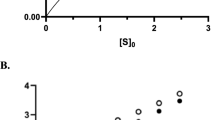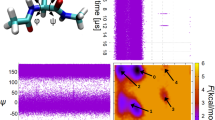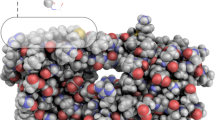Abstract
The role of protein dynamics in enzyme catalysis is a matter of intense current debate. Enzyme-catalysed reactions that involve significant quantum tunnelling can give rise to experimental kinetic isotope effects with complex temperature dependences, and it has been suggested that standard statistical rate theories, such as transition-state theory, are inadequate for their explanation. Here we introduce aspects of transition-state theory relevant to the study of enzyme reactivity, taking cues from chemical kinetics and dynamics studies of small molecules in the gas phase and in solution — where breakdowns of statistical theories have received significant attention and their origins are relatively better understood. We discuss recent theoretical approaches to understanding enzyme activity and then show how experimental observations for a number of enzymes may be reproduced using a transition-state-theory framework with physically reasonable parameters. Essential to this simple model is the inclusion of multiple conformations with different reactivity.
This is a preview of subscription content, access via your institution
Access options
Subscribe to this journal
Receive 12 print issues and online access
$259.00 per year
only $21.58 per issue
Buy this article
- Purchase on Springer Link
- Instant access to full article PDF
Prices may be subject to local taxes which are calculated during checkout



Similar content being viewed by others
References
Nagel, Z. D. & Klinman, J. P. A 21st century revisionist's view at a turning point in enzymology. Nature Chem. Biol. 5, 543–550 (2009).
Kamerlin, S. C. L. & Warshel, A. At the dawn of the 21st century: Is dynamics the missing link for understanding enzyme catalysis? Proteins 78, 1339–1375 (2010).
Rothlisberger, D. et al. Kemp elimination catalysts by computational enzyme design. Nature 453, 190–194 (2008).
Siebrand, W. & Smedarchina, Z. Model for the analysis of enzymatic proton-transfer reactions with an application to soybean lipoxygenase-1 and six mutants. J. Phys. Org. Chem. 23, 620–631 (2010).
Johannissen, L. O., Scrutton, N. S. & Sutcliffe, M. J. How does pressure affect barrier compression and isotope effects in an enzymatic hydrogen tunneling reaction? Angew. Chem. Int. Ed. 50, 2129–2132 (2011).
Schwartz, S. D. & Schramm, V. L. Enzymatic transition states and dynamic motion in barrier crossing. Nature Chem. Biol. 5, 552–559 (2009).
Masgrau, L. et al. Atomic description of an enzyme reaction dominated by proton tunneling. Science 312, 237–241 (2006).
Cha, Y., Murray, C. J. & Klinman, J. P. Hydrogen tunneling in enzyme reactions. Science 243, 1325–1330 (1989).
Basran, J., Sutcliffe, M. J. & Scrutton, N. S. Enzymatic H-transfer requires vibration-driven extreme tunneling. Biochemistry 38, 3218–3222 (1999).
Glickman, M. H. & Klinman, J. P. Nature of rate-limiting steps in the soybean lipoxygenase-1 reaction. Biochemistry 34, 14077–14092 (1995).
Forrest, L. R. et al. Mechanism for alternating access in neurotransmitter transporters. Proc. Natl Acad. Sci. USA 105, 10338–10343 (2008).
Pentikainen, U., Pentikainen, O. T. & Mulholland, A. J. Cooperative symmetric to asymmetric conformational transition of the apo-form of scavenger decapping enzyme revealed by simulations. Proteins 70, 498–508 (2008).
Strickland, N., Mulholland, A. J. & Harvey, J. N. The Fe-CO bond energy in myoglobin: A QM/MM study of the effect of tertiary structure. Biophys. J. 90, L27–L29 (2006).
Koshland, D. E. Application of a theory of enzyme specificity to protein synthesis. Proc. Natl. Acad. Sci. USA 44, 98–104 (1958).
Ma, B. Y. & Nussinov, R. Enzyme dynamics point to stepwise conformational selection in catalysis. Curr. Opin. Chem. Biol. 14, 652–659 (2010).
Zhou, H. X. From induced fit to conformational selection: A continuum of binding mechanism controlled by the timescale of conformational transitions. Biophys. J. 98, L15–L17 (2010).
Vértessy, B. G. & Orosz, F. From “fluctuation fit” to “conformational selection”: Evolution, rediscovery, and integration of a concept. BioEssays 33, 30–34 (2011).
Van der Kamp, M. W., Perruccio, F. & Mulholland, A. J. High-level QM/MM modelling predicts an arginine as the acid in the condensation reaction catalysed by citrate synthase. Chem. Commun. 1874–1876 (2008).
Henzler-Wildman, K. A. et al. Intrinsic motions along an enzymatic reaction trajectory. Nature 450, 838–813 (2007).
Venkitakrishnan, R. P. et al. Conformational changes in the active site loops of dihydrofolate reductase during the catalytic cycle. Biochemistry 43, 16046–16055 (2004).
Min, W. et al. Fluctuating enzymes: Lessons from single-molecule studies. Accounts Chem. Res. 38, 923–931 (2005).
Lodola, A. et al. Conformational effects in enzyme catalysis: Reaction via a high energy conformation in fatty acid amide hydrolase. Biophys. J. 92, L20–L22 (2007).
Chouard, T. Breaking the protein rules. Nature 471, 151–153 (2011).
Tokuriki, N. & Tawfik, D. S. Protein dynamism and evolvability. Science 324, 203–207 (2009).
Wolf-Watz, M. et al. Linkage between dynamics and catalysis in a thermophilic-mesophilic enzyme pair. Nature Struct. Mol. Biol. 11, 945–949 (2004).
Daggett, V. Protein folding-simulation. Chem. Rev. 106, 1898–1916 (2006).
Warshel, A. Bicycle-pedal model for the first step in the vision process. Nature 260, 679–683 (1976).
Van der Kamp, M. W., Shaw, K. E., Woods, C. J. & Mulholland, A. J. Biomolecular simulation and modelling: status, progress and prospects. J. R. Soc. Interface 5, S173–S190 (2008).
Lonsdale, R., Harvey, J. N., Manby, F. R. & Mulholland, A. J. Comment on “A stationary-wave model of enzyme catalysis” by Carlo Canepa. J. Comput. Chem. 32, 368–369 (2011).
McGeagh, J. D., Ranaghan, K. E. & Mulholland, A. J. Protein dynamics and enzyme catalysis: Insights from simulations. Biochim. Biophys. Acta 1814, 1077–1092 (2011).
Hammes-Schiffer, S. & Benkovic, S. J. Relating protein motion to catalysis. Annu. Rev. Biochem. 75, 519–541 (2006).
Benkovic, S. J. & Hammes-Schiffer, S. A perspective on enzyme catalysis. Science 301, 1196–1202 (2003).
Garcia-Viloca, M., Gao, J., Karplus, M. & Truhlar, D. G. How enzymes work: Analysis by modern rate theory and computer simulations. Science 303, 186–195 (2004).
Pisliakov, A. V., Cao, J., Kamerlin, S. C. L. & Warshel, A. Enzyme millisecond conformational dynamics do not catalyze the chemical step. Proc. Natl Acad. Sci. USA 106, 17359–17364 (2009).
Pu, J. Z., Gao, J. L. & Truhlar, D. G. Multidimensional tunneling, recrossing, and the transmission coefficient for enzymatic reactions. Chem. Rev. 106, 3140–3169 (2006).
Gilbert, R. G. & Smith, S. C. Theory of Unimolecular and Recombination Reactions (Blackwell, 1990).
Bowman, G. R. & Pande, V. S. Protein folded states are kinetic hubs. Proc. Natl Acad. Sci. USA 107, 10890–10895 (2010).
Huang, R. et al. Direct observation of the full transition from ballistic to diffusive Brownian motion in a liquid. Nature Phys. 7, 576–580 (2011).
Laidler, K. J. Chemical Kinetics 3rd edn (Harper International, 1987).
Lourderaj, U. & Hase, W. L. Theoretical and computational studies of non-RRKM unimolecular dynamics. J. Phys. Chem. A 113, 2236–2253 (2009).
Heazlewood, B. R. et al. Near-threshold H/D exchange in CD3CHO photodissociation. Nature Chem. 3, 443–448 (2011).
Glowacki, D. R. & Pilling, M. J. Unimolecular reactions of peroxy radicals in atmospheric chemistry and combustion. ChemPhysChem 11, 3836–3843 (2010).
Miller, J. A. & Klippenstein, S. J. Master equation methods in gas phase chemical kinetics. J. Phys. Chem. A 110, 10528–10544 (2006).
Glowacki, D. R., Liang, C. H., Marsden, S. P., Harvey, J. N. & Pilling, M. J. Alkene hydroboration: Hot intermediates that react while they are cooling. J. Am. Chem. Soc. 132, 13621–13623 (2010).
Greaves, S. J. et al. Vibrationally quantum-state-specific reaction dynamics of H atom abstraction by CN radical in solution. Science 331, 1423–1426 (2011).
Glowacki, D. R., Marsden, S. P. & Pilling, M. J. Significance of nonstatistical dynamics in organic reaction mechanisms: Time-dependent stereoselectivity in cyclopentyne-alkene cycloadditions. J. Am. Chem. Soc. 131, 13896–13897 (2009).
Glowacki, D. R., Reed, S. K., Pilling, M. J., Shalashilin, D. V. & Martinez-Nunez, E. Classical, quantum and statistical simulations of vibrationally excited HOSO2: IVR, dissociation, and implications for OH + SO2 kinetics at high pressures. Phys. Chem. Chem. Phys. 11, 963–974 (2009).
Harvey, J. N. Ab initio transition state theory for polar reactions in solution. Faraday Discuss. 145, 487–505 (2010).
Cooper, A. Protein heat capacity: An anomaly that maybe never was. J. Phys. Chem. Lett. 1, 3298–3304 (2010).
Knapp, M. J., Rickert, K. & Klinman, J. P. Temperature-dependent isotope effects in soybean lipoxygenase-1: Correlating hydrogen tunneling with protein dynamics. J. Am. Chem. Soc. 124, 3865–3874 (2002).
Loveridge, E. J., Tey, L. H. & Allemann, R. K. Solvent effects on catalysis by Escherichia coli dihydrofolate reductase. J. Am. Chem. Soc. 132, 1137–1143 (2010).
Sikorski, R. S. et al. Tunneling and coupled motion in the Escherichia coli dihydrofolate reductase catalysis. J. Am. Chem. Soc. 126, 4778–4779 (2004).
Fleming, D. G. et al. Kinetic isotope effects for the reactions of muonic helium and muonium with H2 . Science 331, 448–450 (2011).
Wu, T., Werner, H. J. & Manthe, U. First-principles theory for the H+CH4 → H2+CH3 reaction. Science 306, 2227–2229 (2004).
Claeyssens, F. et al. High-accuracy computation of reaction barriers in enzymes. Angew. Chem. Int. Ed. 45, 6856–6859 (2006).
Kanaan, N., Roca, M., Tunon, I., Marti, S. & Moliner, V. Application of Grote-Hynes theory to the reaction catalyzed by thymidylate synthase. J. Phys. Chem. B 114, 13593–13600 (2010).
Alhambra, C., Sanchez, M. L., Corchado, J. C., Gao, J. & Truhlar, D. G. Quantum mechanical tunneling in methylamine dehydrogenase. Chem. Phys. Lett. 347, 512–518 (2001); Erratum ibid. 355, 388–394 (2002).
Lonsdale, R., Harvey, J. N. & Mulholland, A. J. Compound I reactivity defines alkene oxidation selectivity in cytochrome P450cam. J. Phys. Chem. B 114, 1156–1162 (2010).
Truhlar, D. G. Tunneling in enzymatic and nonenzymatic hydrogen transfer reactions. J. Phys. Org. Chem. 23, 660–676 (2010).
Lodola, A. et al. Structural fluctuations in enzyme-catalyzed reactions: Determinants of reactivity in fatty acid amide hydrolase from multivariate statistical analysis of quantum mechanics/molecular mechanics paths. J. Chem. Theory Comput. 6, 2948–2960 (2010).
Warshel, A. & Weiss, R. M. An empirical valence bond approach for comparing reactions in solutions and in enzymes. J. Am. Chem. Soc. 102, 6218–6226 (1980).
Glowacki, D. R., Paci, E. & Shalashilin, D. V. Boxed molecular dynamics: A simple and general technique for accelerating rare event kinetics and mapping free energy in large molecular systems. J. Phys. Chem. B 113, 16603–16611 (2009).
Greaves, S. J. et al. Vibrational excitation through tug-of-war inelastic collisions. Nature 454, 88–91 (2008).
Glowacki, D. R., Rose, R. A., Greaves, S. J., Orr-Ewing, A. J. & Harvey, J. N. Ultrafast energy flow in the wake of solution-phase bimolecular reactions. Nature Chem. 3, 850–855 (2011).
Glowacki, D. R., Orr-Ewing, A. J. & Harvey, J. N. Product energy deposition of CN + alkane H abstraction reactions in gas and solution phases. J. Chem. Phys. 134, 214508 (2011).
Ruggiero, G. D., Williams, I. H., Roca, M., Moliner, V. & Tunon, I. QM/MM determination of kinetic isotope effects for COMT-catalyzed methyl transfer does not support compression hypothesis. J. Am. Chem. Soc. 126, 8634–8635 (2004).
Strajbl, M., Shurki, A., Kato, M. & Warshel, A. Apparent NAC effect in chorismate mutase reflects electrostatic transition state stabilization. J. Am. Chem. Soc. 125, 10228–10237 (2003).
Liu, H. B. & Warshel, A. The catalytic effect of dihydrofolate reductase and its mutants is determined by reorganization energies. Biochemistry 46, 6011–6025 (2007).
Dybala-Defratyka, A., Paneth, P., Banerjee, R. & Truhlar, D. G. Coupling of hydrogenic tunneling to active-site motion in the hydrogen radical transfer catalyzed by a coenzyme B-12-dependent mutase. Proc. Natl Acad. Sci. USA 104, 10774–10779 (2007).
Zuev, P. S. et al. Carbon tunneling from a single quantum state. Science 299, 867–870 (2003).
Schreiner, P. R. et al. Capture of hydroxymethylene and its fast disappearance through tunnelling. Nature 453, 906–942 (2008).
Brunton, G., Griller, D., Barclay, L. R. C. & Ingold, K. U. Kinetic applications of electron paramagnetic resonance spectroscopy. 26. Quantum-mechanical tunneling in the isomerization of sterically hindered aryl radicals. J. Am. Chem. Soc. 98, 6803–6811 (1976).
Olsson, M. H. M., Siegbahn, P. E. M. & Warshel, A. Simulations of the large kinetic isotope effect and the temperature dependence of the hydrogen atom transfer in lipoxygenase. J. Am. Chem. Soc. 126, 2820–2828 (2004).
Liu, H. B. & Warshel, A. Origin of the temperature dependence of isotope effects in enzymatic reactions: The case of dihydrofolate reductase. J. Phys. Chem. B 111, 7852–7861 (2007).
Williams, I. H. Quantum catalysis? A comment on tunnelling contributions for catalysed and uncatalysed reactions. J. Phys. Org. Chem. 23, 685–689 (2010).
Masgrau, L., Ranaghan, K. E., Scrutton, N. S., Mulholland, A. J. & Sutcliffe, M. J. Tunneling and classical paths for proton transfer in an enzyme reaction dominated by tunneling: Oxidation of tryptamine by aromatic amine dehydrogenase. J. Phys. Chem. B 111, 3032–3047 (2007).
Ranaghan, K. E., Masgrau, L., Scrutton, N. S., Sutcliffe, M. J. & Mulholland, A. J. Analysis of classical and quantum paths for deprotonation of methylamine by methylamine dehydrogenase. ChemPhysChem 8, 1816–1835 (2007).
Hay, S., Sutcliffe, M. J. & Scrutton, N. S. Promoting motions in enzyme catalysis probed by pressure studies of kinetic isotope effects. Proc. Natl Acad. Sci. USA 104, 507–512 (2007).
Pang, J. Y., Pu, J. Z., Gao, J. L., Truhlar, D. G. & Allemann, R. K. Hydride transfer reaction catalyzed by hyperthermophilic dihydrofolate reductase is dominated by quantum mechanical tunneling and is promoted by both inter- and intramonomeric correlated motions. J. Am. Chem. Soc. 128, 8015–8023 (2006).
Agmon, N. & Hopfield, J. J. CO binding to heme proteins: A model for barrier height distributions and slow conformational changes. J. Chem. Phys. 79, 2042–2053 (1983).
Knowles, J. R. Enzyme catalysis: Not different, just better. Nature 350, 121–124 (1991).
Skodje, R. T. & Truhlar, D. G. Parabolic tunneling calculations. J. Phys. Chem. 85, 624–628 (1981).
Acknowledgements
A.J.M. is an EPSRC Leadership Fellow (EP/G007705/1). J.N.H. and D.R.G. thank EPSRC for support (Programme Grant EP/G00224X). Thanks to K.E. Ranaghan for providing Fig. 1, and for useful comments along with M. W. van der Kamp.
Author information
Authors and Affiliations
Corresponding authors
Ethics declarations
Competing interests
The authors declare no competing financial interests.
Rights and permissions
About this article
Cite this article
Glowacki, D., Harvey, J. & Mulholland, A. Taking Ockham's razor to enzyme dynamics and catalysis. Nature Chem 4, 169–176 (2012). https://doi.org/10.1038/nchem.1244
Published:
Issue Date:
DOI: https://doi.org/10.1038/nchem.1244
This article is cited by
-
Acceleration of enzymatic catalysis by active hydrodynamic fluctuations
Communications Physics (2022)
-
Modeling Catalysis in Allosteric Enzymes: Capturing Conformational Consequences
Topics in Catalysis (2022)
-
Pervasive cooperative mutational effects on multiple catalytic enzyme traits emerge via long-range conformational dynamics
Nature Communications (2021)
-
The evolution of multiple active site configurations in a designed enzyme
Nature Communications (2018)
-
Reaction and diffusion thermodynamics explain optimal temperatures of biochemical reactions
Scientific Reports (2018)



